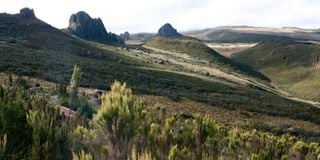In the land of dragons

The Northern Moorlands of the Abardare Range.
After four hours of smooth tarmac, we turn off onto a murram road and begin the slow climb to the Shamata Gate. The northern slopes of the Aberdares are hidden in a thick mist above us, and a persistent drizzle spatters our windscreen. We follow signs to the gate through still rural settlements, where we pick up some last-minute supplies for a wet weekend in the moorlands.
In truth, we don’t really know what to expect. I’m very familiar with the Salient and southern circuit of the Aberdares – a wildlife-rich landscape of montane rainforest and tall waterfalls. But the high northern sector, separated from the south by a long saddle of land above 3,000 metres, is new to me. The little I do know, of sites with grand and mythical names like Dragon’s Teeth, lends our excursion a sense of other-worldly discovery.
This impression isn’t lost as we drive through the gate into an enchanting stretch of cedar forest. The rain has cleared and long shards of light angle through the canopy. I see a flash of white, and then another – a troop of colobus monkeys scatters through the dense foliage.
Twin Rocks
As the road climbs, the forest thins, offering a glimpse of two imposing rock structures in an open moorland ahead. We assume that these are the Twin Rocks, a striking landmark and our base for the next two nights.
Beneath one of the rocks, we find a sunken fire pit with a pile of sodden logs. I’m glad I remembered to pack our own firewood. We set up camp in the soft evening light, enjoying the last of the day’s warmth.
To the west, the ridge gradually falls away, and there are long views down to Ol Kalou and Lake Olbolosat. In every other direction are rolling plains of tussock grass and giant heather. Soon after the sun sinks below the horizon, the wind picks up and the temperature plummets.
At dawn the following morning, we drive back to the gate to pick up Tom, a KWS ranger and our guide for the day’s hike. We leave the car at the Twin Rocks and trek southwards across the moorlands along well-trodden animal tracks. Tom is in full camo, but I notice he’s wearing gumboots – not ideal for a 17 kilometre hike.
Dragon’s Teeth
Our destination is a unique rock formation called the Dragon’s Teeth, and beyond that Ol Donyo Lesatima, the highest point of the Aberdares Range. Forming a section of the eastern shoulder of the Great Rift Valley, the range is full of extraordinary volcanic rock structures, created around six million years ago.
We follow Tom into a wide, mist-cloaked valley. A gap appears in the mist on the opposite ridge, revealing an impressive, conical tower of rock. I ask Tom whether it has a name, anticipating something mighty and folkloric. “The Nipple,” he says.
As I photograph The Nipple, my right leg sinks knee-deep into a mud hole by the side of the path. I now appreciate Tom’s choice of footwear.
We trudge on through the marshy valley into a high amphitheatre of rocks. “The Dragon’s Teeth,” Tom announces. Around us are tall, jagged peaks, dotted with giant groundsels and other alien alpine plants. Slender-billed starlings squawk and glide overhead. Beyond the teeth is another reptilian outcrop – a row of angular rocks in a long arc like the spikes along a dragon’s spine.
We tackle a few more ridges and the short, steep final ascent to the 4,001-metre-high Ol Donyo Lesatima peak. The views back towards Lake Olbolosat, and to the isolated valleys further south, are incredible.
I step closer to the edge, and spot a lone buffalo trotting away from us down below. I don’t mind that we haven’t seen much wildlife in this northern circuit of the Aberdares. The beasts up here are mythical and set in stone, and it’s a privilege to walk among them.





